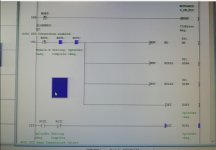Mas01
Member
Hi,
I'm planning to install a new Analogue Input module Q68AD-G.
It will inserted on Rack 0 Slot 4.
When it's installed, will the code recognise e.g. R0S4 (module ready), R0S4 (SettingRequest) and R0S4 (Setting Completed), in a similar way to the code below? (not the best screenshot, as it's from an AO module, but you get the idea). Or will they all need to be defined.
Also, I don't understand how the same register name, R0S10, can be 'commented' with three different strings. How is this possible? They look the same from the name, but they must be different things, right?
Thanks


I'm planning to install a new Analogue Input module Q68AD-G.
It will inserted on Rack 0 Slot 4.
When it's installed, will the code recognise e.g. R0S4 (module ready), R0S4 (SettingRequest) and R0S4 (Setting Completed), in a similar way to the code below? (not the best screenshot, as it's from an AO module, but you get the idea). Or will they all need to be defined.
Also, I don't understand how the same register name, R0S10, can be 'commented' with three different strings. How is this possible? They look the same from the name, but they must be different things, right?
Thanks

Last edited:




